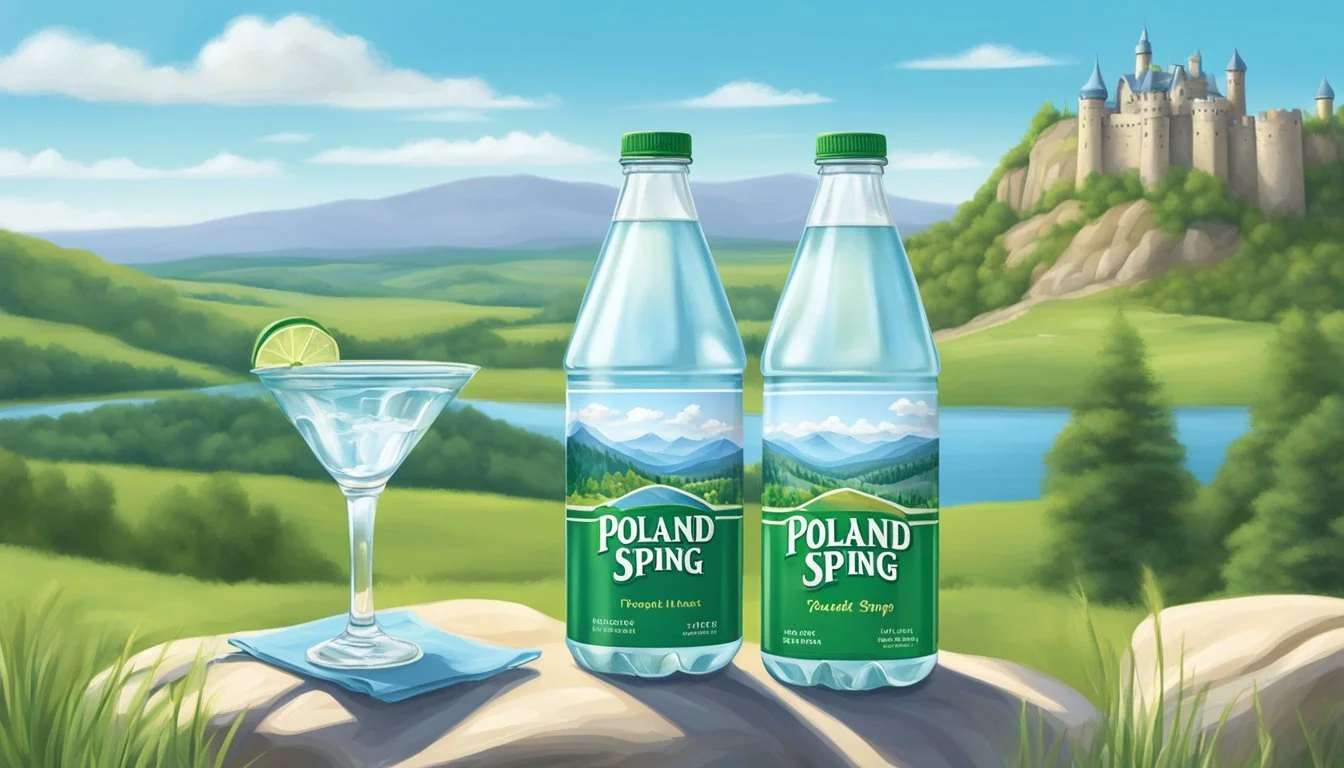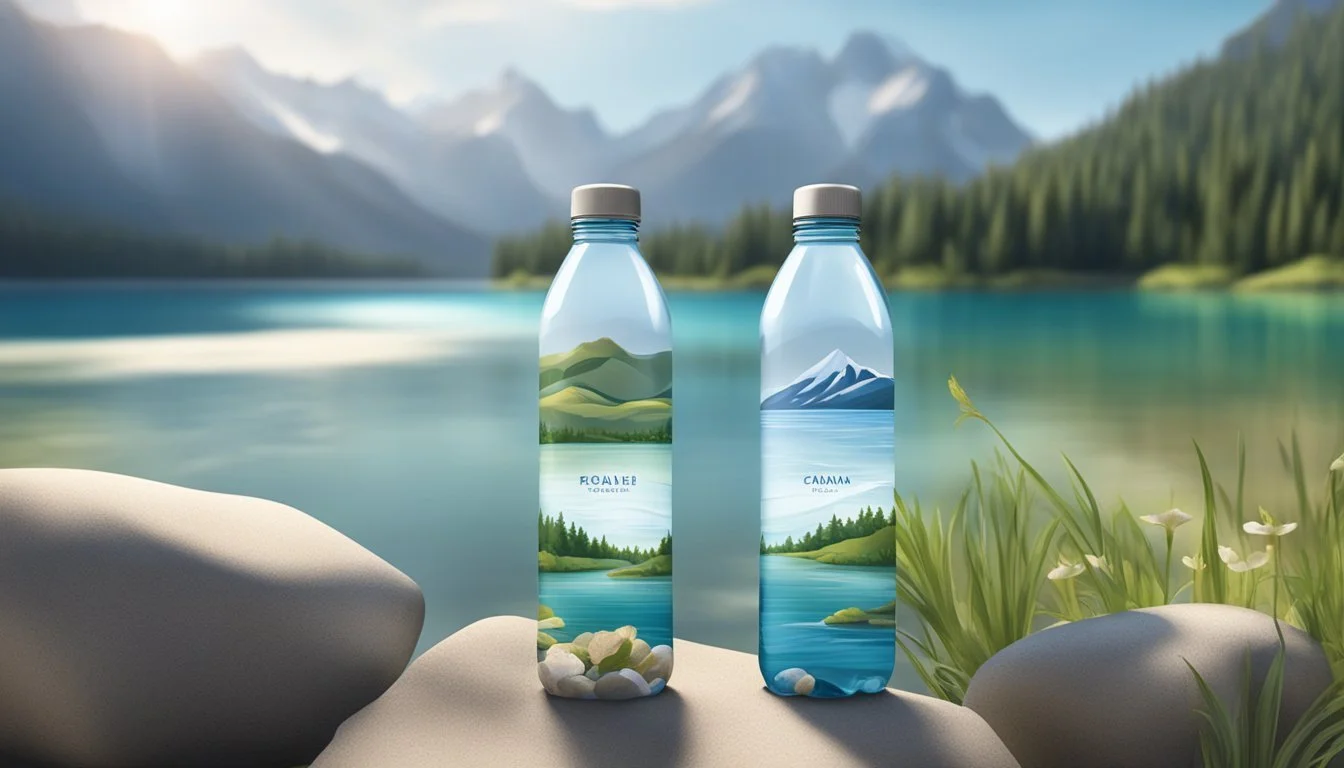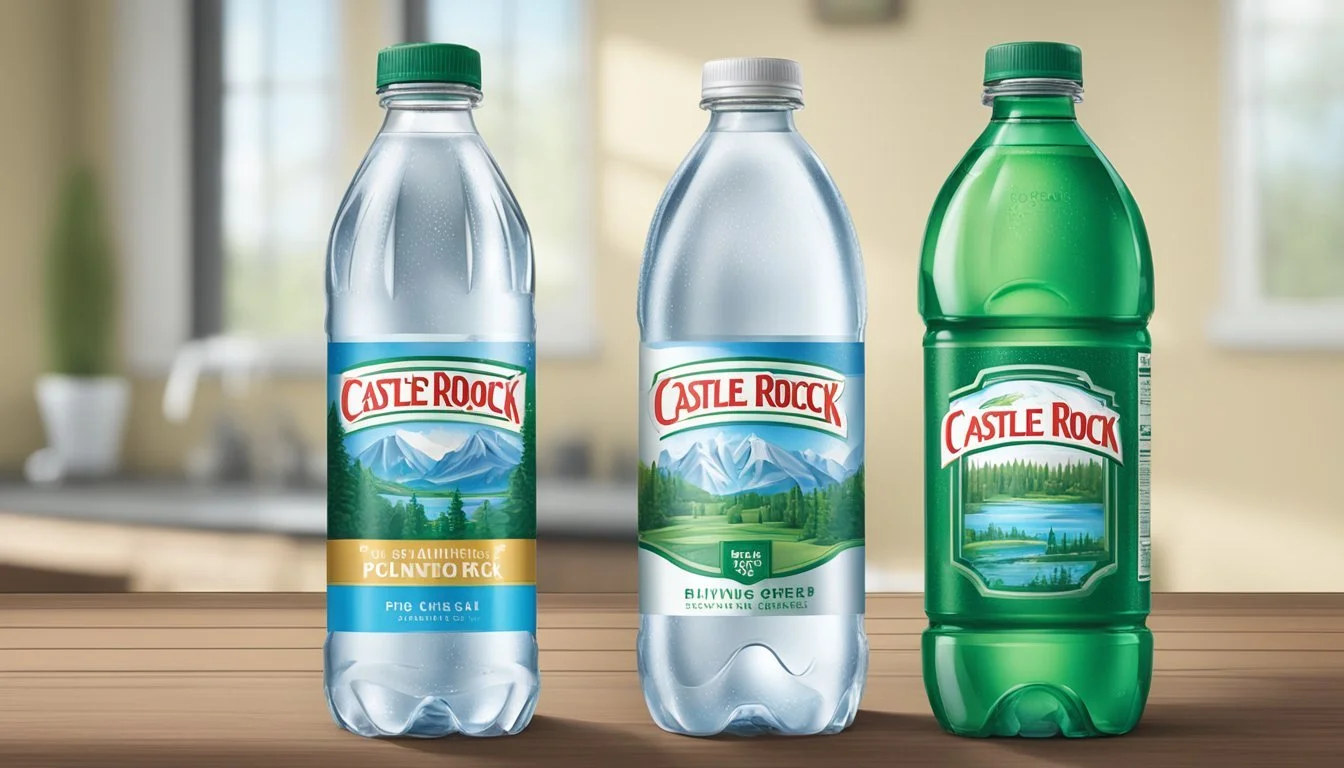Poland Spring vs. Castle Rock
A Comparative Analysis of Bottled Water Quality
When it comes to bottled water, consumers are often faced with a plethora of choices, each claiming to offer the purest and most refreshing experience. Among these options, Poland Spring and Castle Rock stand out as two prominent brands. From the crystal clear springs of Maine, Poland Spring has built its reputation on providing a reliable and recognizable product. On the other hand, Castle Rock, sourced from pristine natural springs in California, offers a different appeal with its focus on sustainable practices and artisanal quality.
For those seeking a water brand that balances accessibility and quality, Poland Spring remains a steadfast option, easily found in many stores across the United States with a taste that is familiar to many. Castle Rock, meanwhile, tends to attract those who are looking for a more unique and environmentally conscious choice, often viewed as a premium product due to its meticulous sourcing and commitment to eco-friendly bottling.
By comparing Poland Spring and Castle Rock, readers can gain insights into which bottled water brand aligns with their personal preferences and values. Whether it's the widespread availability and consistent taste of Poland Spring or the artisanal quality and sustainability of Castle Rock, this article aims to help consumers make an informed decision in their quest for the better bottled water option.
Understanding Bottled Water
When selecting bottled water, it's important to consider the different types available, the safety standards they must adhere to, and the environmental impact of their production and disposal.
Types of Bottled Water
Bottled water comes in several varieties, each with distinct characteristics. Natural spring water is sourced from underground formations and must be collected at the spring. It contains minerals that are naturally present in the water.
Purified water is water that has been processed to remove contaminants and impurities. This category includes distilled, deionized, and reverse osmosis water. While purified water may be sourced from any type of water, it undergoes extensive treatment to ensure purity.
Mineral water contains a high concentration of minerals which can provide health benefits. The mineral content remains constant and comes from the source. Different brands offer variations in taste and health claims due to these unique mineral profiles.
Bottled Water Safety Standards
To ensure bottled water is safe for consumption, regulatory bodies such as the U.S. Food and Drug Administration (FDA) set strict standards. Bottled water must comply with these regulations, which cover permissible levels of contaminants and bacteria.
Testings include checks for microbial pathogens, toxic substances, and chemical pollutants. Additionally, both the source and the final product undergo scrutiny to ensure compliance. This regulatory framework is in place to protect public health by maintaining high standards for drinking water safety.
Labels on bottled water often indicate compliance with these standards, providing consumers with confidence in their choice.
Environmental Impact of Bottled Water
The production, transportation, and disposal of bottled water have significant environmental repercussions. Plastic bottles contribute to pollution due to their non-biodegradable nature. Though some are recyclable, many end up in landfills or oceans, causing long-term environmental damage.
The process of bottling water also consumes substantial natural resources, including water and fossil fuels. It generates greenhouse gases due to the energy required for production and transportation.
Consumers can mitigate some of these impacts by choosing brands that use eco-friendly packaging and supporting efforts to reduce plastic waste. For instance, opting for recyclable bottles or companies that prioritize sustainable practices helps lessen the environmental footprint of bottled water.
The Source Matters
The origin of bottled water significantly influences its quality, taste, and sustainability. For both Poland Spring and Castle Rock, the source of their water is a key factor that sets them apart.
Exploring Natural Spring Water
Poland Spring sources its water from multiple natural springs in the state of Maine. These springs are carefully chosen to ensure a steady supply of pure, natural spring water. The company emphasizes the natural filtration process of the springs, which enhances the water's taste.
Castle Rock, on the other hand, prides itself on sourcing water from a single spring in the pristine Shasta-Trinity National Forest in California. This isolated location ensures that the water remains uncontaminated by urban pollutants. Additionally, the natural surroundings contribute to the purity and mineral content of Castle Rock's water.
Both brands highlight the importance of using natural springs to source their water, but their geographic locations offer unique benefits and challenges. Poland Spring leverages a variety of locations to ensure consistent supply, while Castle Rock focuses on the purity derived from a remote, singular source.
Purity and Contaminants
Purity is a crucial factor when evaluating bottled water. Poland Spring undergoes rigorous testing to ensure there are no contaminants in its water. The multi-source approach helps them maintain high standards, detecting and mitigating any potential issues quickly.
Castle Rock, with its water sourced from a protected forest area, naturally has fewer contaminants. The lack of nearby industrial or agricultural activities minimizes the risk of pollutants. This source ensures that Castle Rock water remains high in natural purity, supported by regular testing to verify its quality.
Both brands take extensive measures to guarantee the purity of their water, but the environmental surroundings of Castle Rock's source provide an added layer of natural protection against contaminants. Poland Spring's diversified approach helps maintain consistent quality across its multiple sources, balancing purity with reliable supply.
Poland Spring: A Closer Look
Poland Spring, a well-known bottled water brand, has a storied heritage and has become a staple in households across the United States. This section explores the origins, extraction processes, and market presence of Poland Spring.
Origins and Extraction
Poland Spring traces its roots back to Maine, where it sources its water from. The brand claims to utilize natural spring water, which is often a mix from multiple sources, ensuring a consistent product. Historically, Poland Spring has emphasized its heritage, marketing its origins since its establishment in the 19th century.
The extraction process involves stringent quality control measures. Third-party testing experts ensure compliance with FDA and EPA standards, maintaining the integrity of the water. Poland Spring is owned by BlueTriton, which took over from Nestlé.
Branding and Market Presence
Poland Spring's branding focuses on trust and affordability. Its reputation as an economical choice contrasts with more luxurious brands like Evian. Poland Spring's marketing emphasizes purity, natural origins, and a strong connection to the state of Maine.
In terms of market presence, Poland Spring is a dominant player in the bottled water industry. With a widespread distribution network, it is readily available in supermarkets and convenience stores nationwide. Despite controversies regarding its water sources, Poland Spring remains a consumer favorite due to its availability and consistent quality.
Castle Rock: Brand Insight
Castle Rock is a highly regarded bottled water brand known for its pristine origin and dedicated sustainability efforts. This section provides an in-depth look at where Castle Rock water comes from and how the company prioritizes environmental responsibility.
Source and Quality
Castle Rock sources its water from pristine springs in the mountains, ensuring a natural and refreshing hydration experience. The water is noted for its crisp flavor, akin to the sensation of a morning hike in the mountains. No significant aftertaste is detected, indicating a high level of purity. This high-quality spring water embodies the essence of its natural origin, making it a favorite among bottled water enthusiasts.
Sustainability and Ethos
Castle Rock is committed to sustainability and ethical business practices. The brand employs eco-friendly bottling processes and contributes to environmental conservation efforts. It focuses on reducing plastic waste by using recyclable materials and supporting local conservation projects. Castle Rock positions itself not just as a provider of high-quality hydration but also as a responsible steward of the environment.
Comparative Analysis
When comparing Poland Spring and Castle Rock, several key factors influence consumer choices, including taste profile, mineral content, packaging convenience, and health benefits. Each brand offers unique characteristics, affecting how consumers perceive their quality and value.
Taste Profile and Mineral Content
Poland Spring and Castle Rock have distinct taste profiles. Poland Spring is known for its clean and crisp taste, derived from natural springs in Maine. It undergoes rigorous filtration, ensuring consistency in every bottle.
Castle Rock, sourced from some of the purest springs in Northern California, offers a smooth and refreshing taste. The mineral content in Castle Rock water is naturally balanced, adding a slight hint of minerals, enhancing its unique flavor. Poland Spring also maintains a natural mineral composition, contributing to its signature taste.
Packaging and Convenience
Poland Spring prioritizes convenience with a variety of bottle sizes. Their packaging is lightweight and user-friendly, suitable for on-the-go hydration. They have also invested in eco-friendly initiatives, using recycled materials in their bottles, reflecting a commitment to environmental sustainability.
Castle Rock emphasizes both aesthetics and functionality in packaging. Their bottles are designed for a premium look and feel. Despite being slightly heavier, they reflect Castle Rock’s dedication to quality and durability. Similar to Poland Spring, Castle Rock also focuses on environmentally conscious practices, utilizing recycled and sustainable materials.
Health and Hydration Benefits
Poland Spring offers consistent hydration benefits, perfect for daily needs. The natural filtration process ensures the water remains free from contaminants while retaining beneficial minerals. Poland Spring is a reliable choice for maintaining daily hydration.
Castle Rock excels in providing not only hydration but also additional health benefits. It boasts a higher mineral content, which can be advantageous for those seeking mineral-rich water. Electrolytes present in Castle Rock water aid in quicker and more effective hydration, especially valuable during physical activities.
In summary, both Poland Spring and Castle Rock provide quality bottled water options, each with their own strengths in taste, packaging, and health benefits.
Consumer Perspectives
When it comes to bottled water, consumers prioritize taste, quality, and convenience. Brand loyalty often influences purchasing decisions, with market trends reflecting evolving preferences.
Market Trends and Preferences
Market trends reveal a growing demand for quality bottled water. Consumers look for brands that promise purity and superior taste. Poland Spring has established a reputation for its natural spring water sourced from Maine, emphasizing its unprocessed purity.
In contrast, Castle Rock appeals to eco-conscious consumers with its commitment to sustainability, using eco-friendly packaging. Both brands cater to distinct segments; Poland Spring focuses on tradition and quality, while Castle Rock targets environmentally aware buyers.
Customer Reviews and Feedback
Customer reviews highlight varying opinions on Poland Spring and Castle Rock. Poland Spring is often praised for its clean taste and widespread availability. However, some consumers criticize it for contributing to plastic waste.
Castle Rock receives accolades for its environmentally friendly approach and unique, crisp taste. However, its higher price point can be a deterrent for some. Brand loyalty plays a significant role, with many consumers sticking to their preferred brand for years, underscoring the impact of marketing and perceived brand values.
Lists of pros and cons found in reviews further capture consumer sentiment, offering potential buyers a comprehensive overview to make informed choices.
Regulations and Safety
Poland Spring and Castle Rock bottled water adhere to stringent regulatory standards to ensure consumer safety. Both brands must meet federal and state guidelines and engage in third-party testing to verify water quality.
Federal and State Guidelines
Both Poland Spring and Castle Rock are subject to guidelines set by the Environmental Protection Agency (EPA) and the Food and Drug Administration (FDA). These agencies regulate contaminants in drinking water to ensure it is safe for consumption.
Federal guidelines cover contaminants like lead, ensuring bottled water is free from harmful levels. Each state also imposes its own safety standards. For instance, Maine's regulations for Poland Spring originate from the state's focus on protecting natural springs.
Regular testing ensures compliance with these regulations. Bottled water companies must submit reports to demonstrate adherence to safety standards. This helps to maintain consumer trust in the quality and safety of their products.
Importance of Third-Party Testing
Third-party testing plays a crucial role in verifying water quality for both Poland Spring and Castle Rock. Independent laboratories are employed to test for contaminants and ensure the water meets all regulatory requirements.
Testing focuses on multiple factors, including the presence of phthalates and microplastics, which are concerning for many consumers. Third-party verification provides an additional layer of accountability beyond federal and state guidelines.
This testing ensures that claims about the purity of water from natural springs are backed by scientific data. It also helps brands maintain transparency and consumer trust by providing unbiased validation of their safety measures.
Conclusion
When comparing Poland Spring and Castle Rock, several factors come into play.
Hydration: Both brands offer high-quality hydration. Poland Spring sources its water from natural springs in Maine, while Castle Rock brings crisp spring water with a refreshing flavor.
Quality: Poland Spring maintains a consistent taste and adheres to strict purification standards. Castle Rock is appreciated for its clean, mountain-like flavor, often favored by consumers for its minimal aftertaste.
Environmental Impact: Poland Spring has made strides in sustainability by offering recyclable bottles and engaging in water conservation efforts. Castle Rock, on the other hand, emphasizes eco-friendly practices and sustainable sourcing, which appeals to environmentally conscious consumers.
Sustainability: Castle Rock stands out with its commitment to environmental responsibility. It uses recyclable packaging and renewable energy sources. Poland Spring also works on reducing its carbon footprint and improving its packaging sustainability.
Consumers: Preferences vary among consumers. Those who prioritize crisp flavor may lean towards Castle Rock. For those who value tradition and consistent quality, Poland Spring remains a trusted choice.
Each brand has its strengths in quality, sustainability, and consumer satisfaction. The choice between them depends on individual preferences and values concerning these factors.
More About Poland Spring
Acqua Panna vs Poland Spring: Which Bottled Water is Better?
Boxed Water vs Poland Spring: Which Bottled Water is Better?
Core Hydration vs Poland Spring: Which Bottled Water is Better?
Ice Mountain vs Poland Spring: Which Bottled Water is Better?
Icelandic Glacial vs Poland Spring: Which Bottled Water is Better?
Mountain Valley Spring Water vs Poland Spring: Which Bottled Water is Better?
Nestle Pure Life vs Poland Spring: Which Bottled Water is Better?
Poland Spring vs Aqua Carpatica: Which Bottled Water is Better?
Poland Spring vs Cascade Mountain: Which Bottled Water is Better?
Poland Spring vs Crystal Geyser: Which Bottled Water is Better?
Poland Spring vs Crystal Lake: Which Bottled Water is Better?
Poland Spring vs Essence pH10: Which Bottled Water is Better?
Poland Spring vs Hawaii Volcanic: Which Bottled Water is Better?
Poland Spring vs Hawaiian Springs: Which Bottled Water is Better?
Poland Spring vs Kirkland Signature: Which Bottled Water is Better?
Poland Spring vs Liquid Death: Which Bottled Water is Better?
Poland Spring vs Proud Source: Which Bottled Water is Better?
Poland Spring vs Purely Sedona: Which Bottled Water is Better?
Poland Spring vs Richard's Rainwater: Which Bottled Water is Better?
Poland Spring vs San Pellegrino: Which Bottled Water is Better?
Poland Spring vs Simple Truth: Which Bottled Water is Better?
Poland Spring vs Solan de Cabras: Which Bottled Water is Better?
Poland Spring vs Talking Rain AQA: Which Bottled Water is Better?
Poland Spring vs Weird Water: Which Bottled Water is Better?
Poland Spring vs Whole Foods 365: Which Bottled Water is Better?
Poland Spring vs Whole Foods Italian Still Mineral water: Which Bottled Water is Better?
Poland Spring vs Zephyrhills: Which Bottled Water is Better?
More About Castle Rock
Aqua Carpatica vs Castle Rock: Which Bottled Water is Better?
Castle Rock vs Cascade Mountain: Which Bottled Water is Better?
Castle Rock vs Crystal Geyser: Which Bottled Water is Better?
Castle Rock vs Hawaii Volcanic: Which Bottled Water is Better?
Castle Rock vs Hawaiian Springs: Which Bottled Water is Better?
Castle Rock vs Kirkland Signature: Which Bottled Water is Better?
Castle Rock vs Purely Sedona: Which Bottled Water is Better?
Castle Rock vs Richard's Rainwater: Which Bottled Water is Better?
Castle Rock vs Solan de Cabras: Which Bottled Water is Better?
Castle Rock vs Talking Rain AQA: Which Bottled Water is Better?
Castle Rock vs Whole Foods 365: Which Bottled Water is Better?
Castle Rock vs Whole Foods Italian Still Mineral water: Which Bottled Water is Better?
Core Hydration vs Castle Rock: Which Bottled Water is Better?
Icelandic Glacial vs Castle Rock: Which Bottled Water is Better?
Mountain Valley Spring Water vs Castle Rock: Which Bottled Water is Better?
Nestle Pure Life vs Castle Rock: Which Bottled Water is Better?
San Pellegrino vs Castle Rock: Which Bottled Water is Better?







